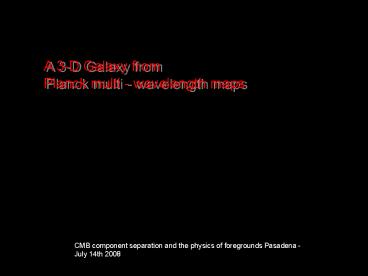Diapositive 1 - PowerPoint PPT Presentation
1 / 50
Title: Diapositive 1
1
A 3-D Galaxy from Planck multi - wavelength maps
Roberta Paladini SSC/Caltech
CMB component separation and the physics of
foregrounds Pasadena - July 14th 2008
2
(No Transcript)
3
The inversion Method
- First introduced by Bloemen et al. (1986, 1990)
and used by Giard et al. (1994), Sodroski et al.
(1997) - Given an input map ( I.e. Planck map at
wavelength ????CMB-subtracted) and a set of basis
(I.e. template maps) , the input maps is
decomposed with respect to the basis through
minimization of the ?? - ?With respect to other component separation
methods, it allows to trace variations of the
physical properties of the emitting material with
respect to distance from Galactic Centre - A first version of the software is already
available and it has been successfully tested on
currently available data sets (Paladini et al.,
2007, AA, 465, 839 )
4
Decomposition of the observed infrared emission
H component
HI component
CO component
HI
e
, i
l
,
5
DATABASE (Paladini et al. 2007)
- INPUT MAPS
- IRAS 60, 100 mm
DIRBE 140, 240 mm Archeops (143, 353 GHz) WMAP
(23, 33, 41, 61, 94 GHz)
- HI Kalberla et al. 2005 ( LAB Survey )
- H2 ? CO NANTEN Dame et al. 2001 Dame et
al. 1987 - Diffuse H WMAP free-free template
- Discrete H HII regions Paladini et al. 2003
Catalog
- TEMPLATES
6
FIRST STEP RING DECOMPOSITION
7
(No Transcript)
8
(No Transcript)
9
EMISSIVITY SPECTRA
10
(No Transcript)
11
(No Transcript)
12
(No Transcript)
13
Lagache, 2003, AA, 405, 831
14
TEMPERATURES
Gas Phase Ring (Kpc) T (K)
HI
0.1-4 22.2/-0.2
4-5.6
22.9/-0.5
5.6-7.2 21.1/-1.01
7.2-8.9 19.8/-1.4
8.9-14
17.8/-2.9
14-17 15.4/-7.1
H2 0.1-4
32.7/17.4
4-5.6
21.7/-3.2
5.6-7.2 18.7/-2.4
7.2-8.9 16.9/-5.2
8.9-14
17.4/-7.2
14-17 18.6/-222.0
HII regions 0.1-4
23.6/-3.5
4-5.6
29.2/-0.3
5.6-7.2 30.0/-0.8
8.9-14 ----------
14-17
---------- H
0.1-17 28.7/-0.4
19 K
18 K
28 K
29 K
15
RADIAL DISTRIBUTIONS
16
RESULTS VII FIR LUMINOSITIES
Ring MHI
LFIR, HI MH2
LFIR,H2 MH
LFIR,H
LFIR,HI
LFIR,H2
LFIR,H
MHI
MH2
MH
(108 Msun)
(108 Msun)
(Lsun/Msun)
(Lsun/Msun)
(Lsun/Msun)
(108 Lsun)
(108 Lsun)
(108 Lsun)
(108 Msun)
(kpc)
0.1-4 1.1 104.9 115.4
1.2 0.1 0.1 4-5.6
1.8 25.3 45.6 2.4
3.7 8.8 5.6-7.2 2.4
7.7 18.4 2.2 3.6
7.9 7.2-8.9 3.1 5.2
16.0 1.1 1.3 1.4
8.9-14 15.7 2.1 33.0
1.9 0.9 1.7 14-17
10.8 0.7 7.8 5.1
0.7 3.5 Total Galaxy 34.8
----- 263.3 13.9 ----
23.5 0.42 64.9 27.2
17
Application of the code Hi-Gal (OTKP)
simulations ( R. Paladini J. Neves)
18
adding a spiral arm model and sources (Russeil
2003)
70 µm
(slide Joao Neves)
19
Example of simulated diffuse source component
l 22 deg
70?m
??0?m
??0?m
??0?m
??0?m
??0?m
20
PSD Planck Sky (ancillary) Data
PSD Planck Sky (ancillary) Data
- Currently Contains- COBE. DIRBE. DMR.
FIRAS- IRIS/IRAS (12, 25, 60, 100 mm).
Holes/no-holes- WMAP (1 year). Freq, Smth., MEM
maps- Archeops (545, 353, 217, 143 GHz)- CO
(integrated intensity Dwingeloo Argentina) -
Av (from DSS star counts by Dobashi et al.) - HI
(Dwingeloo Argentina)
(slide J.-P. Bernard)
J-Ph. Bernard, Planck WG7 meeting, May 6th 2008,
IAS , France
21
PSD Recent Future work
Recent work
Future work
- Ingestion of Nagoya survey CO cubes
- Ingestion of GPS HI survey cubes
- Ingestion of large IR datasets from Spitzer ?
- Ingestion of GPS Radio surveys ?
- Speed-up drizzeling code
(ie, very large data sets)
(slide J.-P. Bernard)
J-Ph. Bernard, Planck WG7 meeting, May 6th 2008,
IAS , France
22
CONCLUSIONS
- Inversion methods allow to perform components
separation as well as to reconstruct 3-d spatial
information - Coupled with 3-d distribution of stars,it is
possible to reconstruct the full 3-d picture of
the Galaxy - CMB experiments, exploring the mm-submm range
and large regions of the sky, provide
unprecedented opportunities to study the physics
of foregrounds (e.g. mm- excess, dust models,
anomalous emission, etc)
23
(No Transcript)
24
DIFFUSE COMPONENT OF H
25
RESULTS III longitude profiles
26
(No Transcript)
27
RESULTS IV LATITUDE PROFILES
28
(No Transcript)
29
SOURCE COMPONENT OF H HII REGIONS
30
HII regions
VLSR
Paladini et al. 2003 Catalog ( 1442 HII
regions )
31
(No Transcript)
32
HI LAB SURVEY
33
HI FULL-SKY DATA
( Kalberla et al. 2005 )
http//www.astro.uni-bonn.de/webrai/english/tools
/labsurvey.php
34
Ring 1
35
Ring 2
36
Ring 3
37
Ring 4
38
Ring 5
39
Ring 6
40
(No Transcript)
41
(No Transcript)
42
(No Transcript)
43
(No Transcript)
44
(No Transcript)
45
Insight on dust properties
Peak of emission shifts at different l depending
on T
( Desert et al. 1990 )
DIRBE
IRAS
PLANCK
and b (spectral emissivity index) is not
constant !
It varies with temperature b (T) ( see PRONAOS,
Dupac et al. 1999 )
b 1 instead of 2 ( see FIRAS, Reach et al.
1995 )
46
Overview of the method
1st Step Make the ring basis for HI, CO and
HII regions
2nd Step Decomposition of the map on this basis
HI and CO data cubes
HII regions (measured VLSR) and
diffuse ionized gas (WMAP, Cordes Lazio 2003,
RRLs)
/
Centimeter, mm and submmm map
Galactic Velocity curve
Vrot (R)
c2 Inversion
R
47
From measured velocities to ring decomposition
Vrot(R)
l
, l
Vrot(R0)
48
HI, H2, H COLUMN DENSITIES
- HI
- H2
- H
49
How to recover 3-dimensional information on dust
??
50
RESULTS I EMISSIVITY COEFFICIENTS































